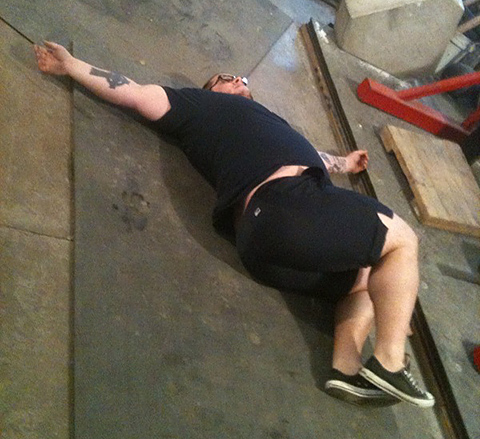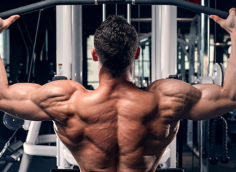I know what you're thinking. "Yoga? On Testosterone Nation? This is a joke, right?"
Yoga isn't for real men. It's for soy-boys, the "weeds and seeds" crowd; those skinny fat Nancies that wear lycra pants and sit around sipping wheatgrass smoothies after their light and invigorating "core circuits."
It certainly isn't for guys built like Silverbacks that can deadlift school buses, guys that consider eating two cups of oats and a dozen whole eggs as skipping breakfast.
No, real men are way too "alpha" for yoga.
Besides, ever take a look inside a yoga class? What could possibly be fruitier than hanging around a room full of limber young women in various states of clingy undress, each bending, twisting and grunting away until they achieve physical positions that you haven't seen since before your girlfriend made you install that draconian porn site blocker on your laptop?
Imagine the humiliation of being the only 250-plus pound guy comfortable enough in his own manhood to bend, stretch, and downward dog in a room full of sweaty, hormonally charged women?
How utterly emasculating would it be to have these women steal glances and occasionally wink at you as they whisper to their friends at how limber you are for such a big, strong guy?
Oh, the humanity.
Friends, I'm here to tell you that yoga is a powerlifter or strongman's best friend, and I don't just mean as a way to meet women. A little yoga can improve your workouts and maybe even extend your lifting career – and you don't have to ditch your current training or join a patchouli-scented yoga studio to take advantage of it.
Let's Get to It!
Before I get into the program, let me begin by saying that I'm not the type of person who implements a strategy into my arsenal unless it meets a few criteria.
- It has to be simple to understand. You know how often I follow a program that requires me to do descending sets of quarter reps with mini blue bands at an 0301 tempo? That's right, never. I lift heavy shit and progress accordingly. I like things simple, but never easy.
- It can't require a bunch of equipment. I like everything in my arsenal to be easy. Yes, I do compete in strongman and it does require specialized equipment, but I only do that type of training once a week. The rest of my program revolves around the staples, i.e. squats, deadlifts, etc.
- It has to make me a better athlete, overall. Enough said.
- It has to work. Considering the world of strength and conditioning has so many systems that are time-tested and proven effective, it baffles me why anyone would waste their time doing something that's basically a crapshoot. Yet every day it seems, a new internet guru emerges promising rock hard abs and amazing strength gains in 30 days for only $9.95.
Let's just say I'm a bit of a skeptic. If I don't know someone who uses it and swears by it, then I more than likely won't give it a second glance. Yoga has been around for thousands of years. If it didn't work, you'd think someone would've called bullshit on it by now. I doubt that you could say the same thing for the Shake-weight.
My Story
I started using yoga because of horrible lower back pain I developed from training and competing in strongman, on top of the other 14 years that I've been training heavy.
Now, when I say back pain, I'm not referring to an annoying "tweak" like the one you got when you set up for deadlifts the wrong way; I'm talking about glued to the floor, not able to walk for three days kind of pain.
I had no clue what was responsible other than I may have been "overusing" my lower back because of how often I trained.
What a line of bullshit that was.
The reason I had lower back pain had nothing to do with my back, rather with tight hamstrings and quads, horrible hip mobility, and tight piriformis. In other words, my ass and hamstrings would spasm, and pull on all the other muscles in my posterior chain, thereby leaving me a cripple for a weekend.
Back Pain = Body Pain
When we're talking about lower back pain – or any pain for that matter – we tend to forget that our body works as a whole, and certain antagonists can either be direct or indirect.
One major cause of lower back pain is sacroiliac misalignment, and since the piriformis originates on the sacrum, when it's tight, this can cause a variety of problems. Also, your sciatic nerve runs through, or close to (depending on your personal anatomy) your piriformis, and dysfunction of the piriformis muscle can cause signs and symptoms of pain in the sciatic nerve distribution; that is, in the gluteal area, posterior thigh, posterior leg, and lateral aspect of the foot.
Another major cause of lower back pain can be from excessive pelvic tilt, whether anterior or posterior. I personally have issues with anterior pelvic tilt from tight hip flexors and quads, but also from week glutes and hamstrings. Stretching out tight muscles and strengthening the weak ones will help with pelvic tilt tremendously.
Enter yoga, which is really just fancy talk for stretching. I started doing a few certain exercises that focused on opening up my hips, strengthening my core and glutes, and limbering up my "big movers."
The result? I can guarantee that I'm one of the most flexible 320-pound guys you'll ever see and since implementing yoga into my program, my pain is virtually gone, my lifts have all improved, and I don't feel like such a train wreck every morning.
The Six Moves
Without further ado, here are six basic yoga moves that you can implement today to help you become an overall better athlete.
1 - The Pigeon Pose

This position is great for stretching the piriformis and opening up the hips. I do these often and they've helped tremendously with my lower back pain.
To begin this stretch, you're going to begin on all fours. Extend one leg straight back, while keeping the other leg bent. The foot on your bent leg should be close to the opposite hip flexor. You should feel a good stretch going right across the middle of your ass on the leg that isn't extended. Stop there and hold.
If you can, try to bring your leg underneath your body, so you can achieve an even deeper stretch. This also works on your IT band. Hold it for about 20 seconds.
2 – Hero Pose

This pose stretches the quadriceps, anterior tibialis, and patellofemoral joint, a.k.a. the knee.
You're going to get into a kneeling position, pushing your knees out as far as possible. Try to get the tops of your feet flat on the floor behind you. Let the hips sink down. You should feel a stretch in your quads and anterior tibialis (shin). If you can't keep the tops of your feet flat on the floor behind you, widen the distance between your knees.
Your hips should be sunk low and your ass should be touching the back of your lower legs.
3 – Belly Twist

This stretches the lower back and is supposed to hydrate the spinal discs (that's a good thing). This will also stretch out your chest, shoulders, and arms.
Lie on your back with your knees bent and your feet close to your ass. Let your knees fall over to one side, making sure they stay together, and keep your alternate shoulder flat on the ground with your arm fully extended out to your side. You should feel a stretch from your hips to your lower back and all the way up to the forearms.
4 – Upward Facing Dog

This pose will open up the chest and stretch the abdominals, as well as the hip flexors.
Lie flat on your stomach, fully extended in the prone position. Bring your hands up to your sides like you're going to do a push up. Push up, but keep your pelvis on the floor and raise your chest and head as high as you can. Squeeze and hold for 30 seconds.
5 – Prayer Squat

Just like it sounds. It's basically a squat, except a little different.
You're going to squat down so that both feet are flat on the ground. You're then going to bring your arms in between your knees and push your knees out with your elbows, bringing your hands together in the middle. You should be able to feel a good stretch in your groin. If you don't, push your knees further out with your elbows until you do feel the stretch.
6 – Bird Dog

This helps to strengthen the core because you're using alternate stabilizing muscles to stay balanced, and it's a good warm up before heavy deadlifts or squats.
First, get on all fours and fully extend one leg behind you. Next, lift your alternate arm straight out in front of you. In other words, if you extend your left leg, you also extend your right arm. Hold this position for about 20 seconds and then switch.
The Set Up
I do all of these poses everyday, especially before a heavy training session.
Start with some calisthenics to get your heart rate up and get some blood flowing, then go right into the movements. Here's what it would look like:
Warm up by walking on a treadmill or jump rope.
- Prayer squat: 30-60 seconds
- Hero pose: 30-60 seconds
- Pigeon pose: 30-60 seconds
- Bird dog: 30 seconds each side
- Upward facing dog: 30-60 seconds
- Belly twist: 30 seconds each side
Focus on getting deeper into the more basic poses before moving onto the more advanced ones.
Wrap Up
Yoga may be a four-letter word for a strength athlete but it shouldn't be. You may be as big as a house and strong as a bull, but if you lack flexibility your training, and eventually your quality of life, will be compromised.
Don't be that big guy we all know that can hammer PR's but has to bribe kids to tie his shoes for him. Get good at these moves and I can guarantee that you'll become a better overall athlete, lifter, or bodybuilder.
And for you guys brave enough to attend the "girly" yoga classes: Don't forget to send me a thank you letter for your ever-growing panty collection.





